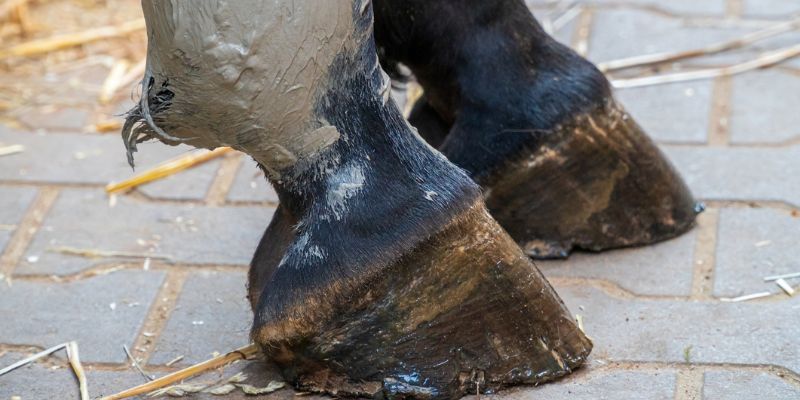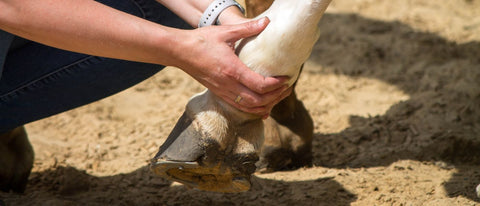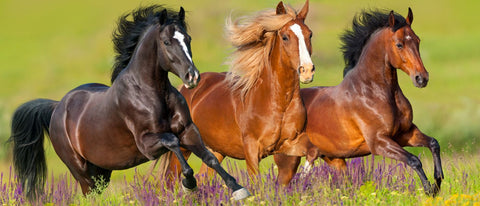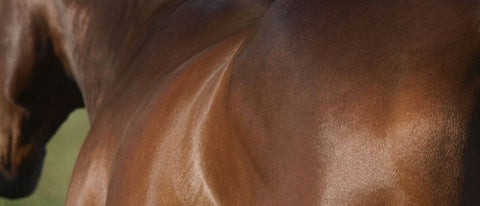
Florian ist aufgewachsen auf einem Bauernhof. Umgeben von Pferden, entdeckte er früh seine Faszination für diese majestätischen Tiere. Inspiriert von seiner reitbegeisterten Mutter, entwickelte er das Nahrungsergänzungmittel - Pferdegold. Seine tiefe Verbundenheit zur Natur und die leidenschaftliche Hingabe zu Pferden trieben ihn an, sein Unternehmen zu gründen.
Gallbladder in horses – a topic that is often misunderstood. But what's really behind it?
Many people may first think of a problem with the horse's bile, but gall in horses has nothing to do with the gallbladder.
In this article, you'll learn everything about galls in horses: their causes, symptoms, and how to treat them.
We'll explore what galls are, how they develop, and why they're an important health issue. Let's take a closer look together and learn how we can better support our horses with gall problems.

What is behind gall in horses?
Galls in horses are more than just a visual abnormality . They are a sign that something is wrong in the horse's body.
They often occur when fluid accumulates in the ankle or other joints.
These fluid accumulations can have various causes, from mechanical irritation to inflammation . In the next section, you'll learn exactly what's behind these galls and why they shouldn't be ignored.
What are the first signs of gallbladder?
The first signs of gall in a horse are often not immediately obvious. It typically begins with mild swelling in the joints , especially in the legs.
These swellings may initially be soft and give way to the touch. In the early stages, galls are often not painful and are therefore easily overlooked by us horse owners.
It is important to have regular check-ups to detect these early signs.
Early detection and treatment can help prevent the progression of gallstones and avoid long-term problems.

Perfect for your horse: Pferdegold® supplementary feed!
These specially developed supplements support your horse's diet and provide it with natural nutrients. Made in Germany, grain-free and drug-free, they come with a 30-day money-back guarantee.
Try it now!What symptoms are typical?
Galls in horses are manifested by a variety of symptoms that go beyond the mere visual appearance .
Here is a detailed list of the typical signs that may indicate the presence of galls:
-
Visible swelling: One of the first and most noticeable signs is swelling on the horse's legs. These may initially be soft and slightly deformed to the touch.
-
Hardening of the galls: Over time, the galls may become hard, often accompanied by an increase in pain when touched .
-
Lameness: Lameness is a common symptom of tendon damage, which can be associated with galls. This manifests itself in an altered gait and a reluctance to move the horse.
-
Changes in gait: In addition to lameness, the horse's overall gait may also change. The horse may take unusual steps or exhibit difficulty moving normally.
-
Discomfort when touched: Horses with galls may show pain or discomfort when the affected area is touched or handled.
-
Warmth and tenderness to pressure: The affected areas may be warm and deform when pressed , indicating an inflammatory reaction.
It is crucial to take these symptoms seriously and seek immediate veterinary attention if gall is suspected.
Early detection and treatment can help prevent long-term complications and ensure the horse's well-being.

Causes of gall in horses: What factors play a role?
Galls in horses are caused by various factors that affect the joints. Excessive strain and stress , whether from intensive training or unfamiliar activities, are common triggers.
Mechanical stimuli such as impacts or pressure from unsuitable equipment can also cause galls. Limb misalignments and previous injuries also play a role.
In addition, nutritional factors, such as an imbalance of important nutrients , can contribute to the formation of bile.
It is important to understand that galls are often an indication of underlying problems and therefore require a comprehensive assessment of the horse's health.
What exactly happens in a joint?
In a healthy joint, synovial fluid ensures the smooth movement of the joint surfaces. It nourishes the cartilage and helps remove waste products.
In the case of bile, however, there is excessive production of this fluid, often in response to inflammation or injury.
The resulting fluid accumulation leads to swelling, which becomes visible as galls. This process can also affect the tendon sheaths and bursae , leading to impairment of normal joint function.
Preventing Gallbladder: Strategies and Tips
Gallbladder in horses can often be avoided through preventative measures. A key to this is appropriate and balanced training that prevents overexertion.
Ensure boots and bandages fit properly to avoid unnecessary pressure. Regular veterinary checkups help detect early signs of problems.
A balanced diet rich in essential nutrients supports overall joint health.
In addition, it is important to take appropriate care of the joints after intensive activities and to plan sufficient rest periods.
Treatment options: What really helps?
The treatment of galls in horses depends largely on the cause and severity . There are several approaches to effectively treat galls.
From less invasive methods to surgical interventions, the choice of gallbladder treatment should always be individualized and in consultation with a veterinarian.
Gallbladder puncture: an overview of the procedure
Bile puncture is a common procedure to remove excess fluid from the affected area .
This procedure uses a fine needle to penetrate the swollen area and suction out the fluid.
This may provide temporary relief , but it is important to note that puncturing is often only a symptomatic treatment .
After the procedure, rest and, if necessary, bandaging are often necessary.
The puncture should always be performed under sterile conditions and by an experienced veterinarian to minimize the risk of infection .

Surgical treatment of hygromas
Hygromas, a specific type of gall, may require surgical treatment .
This type of treatment is usually considered when other methods have not been successful or when the galls are recurrent and painful for the horse.
The surgical procedure aims to remove or correct the affected tissue.
Surgery is usually associated with a longer recovery period , during which the horse requires careful aftercare and possibly additional physiotherapy .
As with any surgery, there are risks, so this option should be carefully discussed with your veterinarian.

Pferdegold® supplementary feed!
Pferdegold is a small family business from Bavaria with a big dream: to produce the best horse feed. We see ourselves as a family of equestrians who want to provide your horse with the ideal nutrition. 100% natural and perfectly tailored to your horse's needs.
Try it now!Alternative healing methods
In addition to traditional medical treatments, there are also alternative remedies for gall in horses. These include acupuncture, homeopathy, and herbal preparations .
These methods can help reduce inflammation and support overall healing.
Physiotherapy and special massage techniques can also help promote circulation and reduce swelling.
It is important, however, that such alternative methods should always be used in consultation with a qualified veterinarian to ensure that they do not harm the horse and that the best possible treatment is provided.
Conclusion
Gallbladder in horses is a complex issue, but with the right knowledge and appropriate approaches, it can be treated effectively.
If you suspect you have gallbladder, it is important not to simply wait and see, but to recognize the first signs early and act proactively.
Whether it's through good care, appropriate feed choices, proper medical care, or a combination of all of these things, you have many options to support your horse.
Because never forget: Your attention is the best thing you can give your horse!
FAQ
How long do galls last?
The duration of galls in horses can vary. In some cases, they can resolve spontaneously within weeks or months, especially if treated early.
However, galls, especially if left untreated, can become chronic and persist long-term.
Regular monitoring and appropriate treatment are therefore essential to ensure the best chance of a full recovery.
Galls vs. swollen legs in horses: What's the difference?
The main difference between galls and swollen legs in horses lies in their cause and appearance.
Galls are specific swellings caused by fluid accumulation in joints, tendon sheaths or bursae.
Swollen legs, on the other hand, are often a sign of lymphatic system impairment and can involve diffuse swelling of the entire leg. While galls are usually localized, swollen legs are generally more widespread and usually affect the entire leg.
IMPORTANT:
Pferdegold is not a substitute for veterinary diagnosis or treatment . The information contained in this article is for general informational purposes only and is intended to help improve your horse's well-being.
Pferdegold products do not treat or cure diseases , but rather support your horse in correcting nutritional deficiencies through targeted nutrient intake. However, they are not a substitute for professional advice from a veterinarian or specialist.
If your horse has any health problems, we strongly recommend consulting a veterinarian . Pferdegold assumes no liability for decisions made based on the information provided here.
Learn more about the world of horses and read our next guides!

















